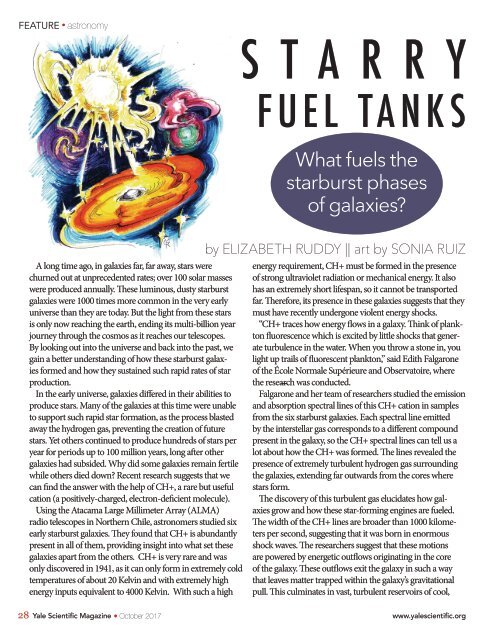YSM Issue 90.4
You also want an ePaper? Increase the reach of your titles
YUMPU automatically turns print PDFs into web optimized ePapers that Google loves.
FEATURE<br />
astronomy<br />
S T A R R Y<br />
FUEL TANKS<br />
What fuels the<br />
starburst phases<br />
of galaxies?<br />
A long time ago, in galaxies far, far away, stars were<br />
churned out at unprecedented rates; over 100 solar masses<br />
were produced annually. These luminous, dusty starburst<br />
galaxies were 1000 times more common in the very early<br />
universe than they are today. But the light from these stars<br />
is only now reaching the earth, ending its multi-billion year<br />
journey through the cosmos as it reaches our telescopes.<br />
By looking out into the universe and back into the past, we<br />
gain a better understanding of how these starburst galaxies<br />
formed and how they sustained such rapid rates of star<br />
production.<br />
In the early universe, galaxies differed in their abilities to<br />
produce stars. Many of the galaxies at this time were unable<br />
to support such rapid star formation, as the process blasted<br />
away the hydrogen gas, preventing the creation of future<br />
stars. Yet others continued to produce hundreds of stars per<br />
year for periods up to 100 million years, long after other<br />
galaxies had subsided. Why did some galaxies remain fertile<br />
while others died down? Recent research suggests that we<br />
can find the answer with the help of CH+, a rare but useful<br />
cation (a positively-charged, electron-deficient molecule).<br />
Using the Atacama Large Millimeter Array (ALMA)<br />
radio telescopes in Northern Chile, astronomers studied six<br />
early starburst galaxies. They found that CH+ is abundantly<br />
present in all of them, providing insight into what set these<br />
galaxies apart from the others. CH+ is very rare and was<br />
only discovered in 1941, as it can only form in extremely cold<br />
temperatures of about 20 Kelvin and with extremely high<br />
energy inputs equivalent to 4000 Kelvin. With such a high<br />
by ELIZABETH RUDDY || art by SONIA RUIZ<br />
energy requirement, CH+ must be formed in the presence<br />
of strong ultraviolet radiation or mechanical energy. It also<br />
has an extremely short lifespan, so it cannot be transported<br />
far. Therefore, its presence in these galaxies suggests that they<br />
must have recently undergone violent energy shocks.<br />
“CH+ traces how energy flows in a galaxy. Think of plankton<br />
fluorescence which is excited by little shocks that generate<br />
turbulence in the water. When you throw a stone in, you<br />
light up trails of fluorescent plankton,” said Edith Falgarone<br />
of the École Normale Supérieure and Observatoire, where<br />
the research was conducted.<br />
Falgarone and her team of researchers studied the emission<br />
and absorption spectral lines of this CH+ cation in samples<br />
from the six starburst galaxies. Each spectral line emitted<br />
by the interstellar gas corresponds to a different compound<br />
present in the galaxy, so the CH+ spectral lines can tell us a<br />
lot about how the CH+ was formed. The lines revealed the<br />
presence of extremely turbulent hydrogen gas surrounding<br />
the galaxies, extending far outwards from the cores where<br />
stars form.<br />
The discovery of this turbulent gas elucidates how galaxies<br />
grow and how these star-forming engines are fueled.<br />
The width of the CH+ lines are broader than 1000 kilometers<br />
per second, suggesting that it was born in enormous<br />
shock waves. The researchers suggest that these motions<br />
are powered by energetic outflows originating in the core<br />
of the galaxy. These outflows exit the galaxy in such a way<br />
that leaves matter trapped within the galaxy’s gravitational<br />
pull. This culminates in vast, turbulent reservoirs of cool,<br />
28 Yale Scientific Magazine October 2017 www.yalescientific.org


















